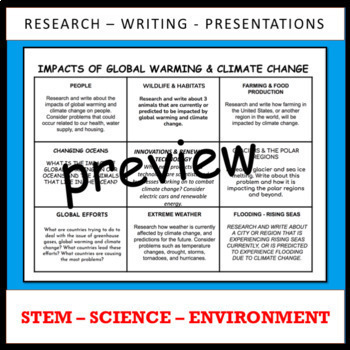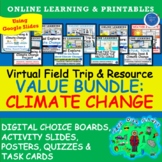Global Warming & Climate Change Research Writing Choice Project Earth Day
Teacher Orbit
773 Followers
Grade Levels
5th - 8th, Homeschool
Subjects
Resource Type
Standards
NGSSMS-ESS3-2
NGSSMS-ESS3-5
NGSSMS-ESS3-3
Formats Included
- Google Slides™
Pages
3 pages
Teacher Orbit
773 Followers

Made for Google Drive™
This resource can be used by students on Google Drive or Google Classroom. To access this resource, you’ll need to allow TPT to add it to your Google Drive. See our FAQ and Privacy Policy for more information.
What educators are saying
My students used this resource for a research & writing assignment that I assigned. It really was helpful & my students really loved exploring the topics related to climate change.
Excellent resource. Love how students get to choose from the menu. All of the topics were super interesting & relevant! Thank you!
Also included in
- Climate Change and human impact on the environment! This VALUE Bundle will provide your students with incredible information about Climate Change Around the World. Students will have the opportunity to analyze data, view interactive maps, watch student friendly videos, engage in online activities, aPrice $24.99Original Price $32.39Save $7.40
Description
Looking for a resource about climate change and the human impact on the environment? This Google Slides resource provides students the opportunity to learn about important environment impacts of global warming & climate change.
How it works:
Using a choice board, your students will choose 3 topics to research, write and/or present! Topics include:
- Extreme Weather
- Polar Regions
- Flooding & Rising Seas
- Impact on Humans
- Impact on Wildlife
- Farming & Food Production
- Changing Oceans
- Global Efforts
Print or Share choice boards online!
Earn TPT Credit!
Did you know that you can receive credit toward future TPT purchases by reviewing this product? If you enjoyed these resources, please take a moment to leave a review. Follow me at Teacher Orbit for product announcements & freebies$$$ Thanks so much!
Total Pages
3 pages
Answer Key
N/A
Teaching Duration
N/A
Report this resource to TPT
Reported resources will be reviewed by our team. Report this resource to let us know if this resource violates TPT’s content guidelines.
Standards
to see state-specific standards (only available in the US).
NGSSMS-ESS3-2
Analyze and interpret data on natural hazards to forecast future catastrophic events and inform the development of technologies to mitigate their effects. Emphasis is on how some natural hazards, such as volcanic eruptions and severe weather, are preceded by phenomena that allow for reliable predictions, but others, such as earthquakes, occur suddenly and with no notice, and thus are not yet predictable. Examples of natural hazards can be taken from interior processes (such as earthquakes and volcanic eruptions), surface processes (such as mass wasting and tsunamis), or severe weather events (such as hurricanes, tornadoes, and floods). Examples of data can include the locations, magnitudes, and frequencies of the natural hazards. Examples of technologies can be global (such as satellite systems to monitor hurricanes or forest fires) or local (such as building basements in tornado-prone regions or reservoirs to mitigate droughts).
NGSSMS-ESS3-5
Ask questions to clarify evidence of the factors that have caused the rise in global temperatures over the past century. Examples of factors include human activities (such as fossil fuel combustion, cement production, and agricultural activity) and natural processes (such as changes in incoming solar radiation or volcanic activity). Examples of evidence can include tables, graphs, and maps of global and regional temperatures, atmospheric levels of gases such as carbon dioxide and methane, and the rates of human activities. Emphasis is on the major role that human activities play in causing the rise in global temperatures.
NGSSMS-ESS3-3
Apply scientific principles to design a method for monitoring and minimizing a human impact on the environment. Examples of the design process include examining human environmental impacts, assessing the kinds of solutions that are feasible, and designing and evaluating solutions that could reduce that impact. Examples of human impacts can include water usage (such as the withdrawal of water from streams and aquifers or the construction of dams and levees), land usage (such as urban development, agriculture, or the removal of wetlands), and pollution (such as of the air, water, or land).





